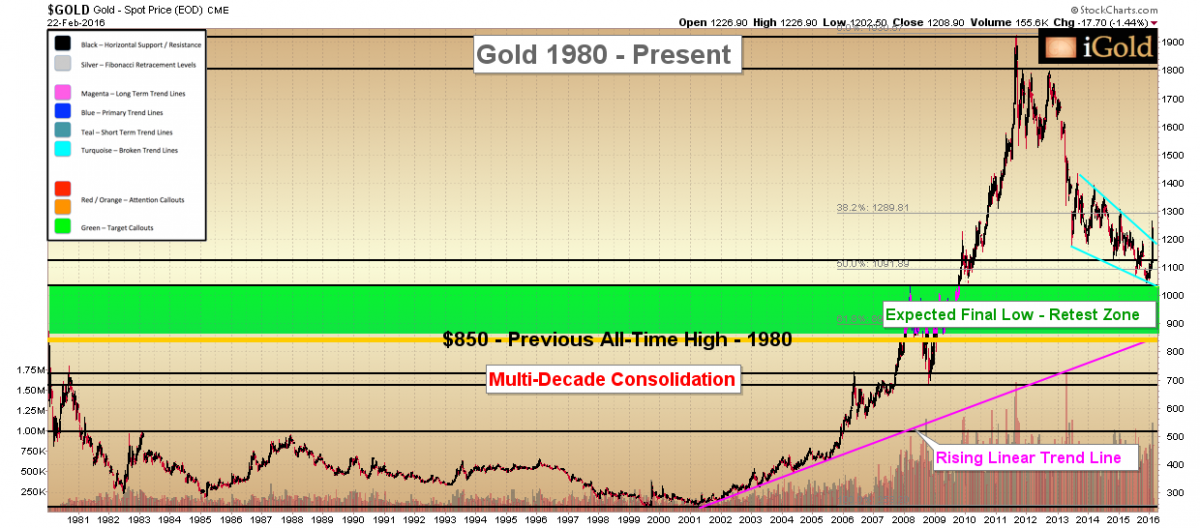Gold Price And Silver Price Forecast – Bullish Consolidations
 The price action for both gold and silver continues to show bullish implications for the establishment of the long-term lows we have been watching for the last several months. What we are seeing now are bullish consolidation patterns, which are very healthy for markets that have had recent strong rises. We are watching several critical support areas for these consolidations, the holding of which would set the precious metals up to begin a trending move to the upside through the later part of this year and into 2017.
The price action for both gold and silver continues to show bullish implications for the establishment of the long-term lows we have been watching for the last several months. What we are seeing now are bullish consolidation patterns, which are very healthy for markets that have had recent strong rises. We are watching several critical support areas for these consolidations, the holding of which would set the precious metals up to begin a trending move to the upside through the later part of this year and into 2017.
Recent Price Action for Gold
Zooming in our charts to better gauge the bottom formations, we can see the clear break of gold's 2.5-year down channel on the recent surge above $1,220. Note that this has broken the series of declining highs as the price moved above the October 2015 high of $1,190. Ideally, we would like to see gold price hold above $1,180-90 on any further weakness and consolidate in the new price level. Such would be very constructive so that the internal workings of the market do not get overstretched too quickly. Quick, rapid price spikes tend to lose momentum and give back much of their gains, whereas slow and steady gains tend to have staying power in the market.
Precious Metals Versus Other Commodities
At the bottom of our gold and silver price charts we will often compare the precious metal to the CRB Commodity Index, which is an index comprised of an average of major world commodities, including industrial metals, oil and the energy complex, agriculture, and the precious metals. This relative strength comparison can allow us to see underlying strength in the precious metals, as even if the price of gold or silver is moving lower, it may be moving higher relative to the CRB Index. High relative strength means that underneath the market, investors are accumulating gold or silver despite broad selling across other world commodities.
Increasing relative strength indicators often tell us when a significant price movement is pending. Such was the case for gold's $200 rise recently, which was foreshadowed nicely when we look at its strong relative strength during the final stages of the decline in 2015.
Recent Price Action for Silver
Silver has broken out of its own downtrend just two weeks ago, which took the shape of a bottoming wedge pattern since 2013. Below we can see the multiple hits on each of the lower and upper declining trend lines, with the recent surge toward $15.85 breaking decisively above upper line. Ideally, we would like to see this broken upper line now serve as support. The longer silver can remain above this broken trend, even if the price were to soften in the next few weeks, the more valid the breakout. While we do not expect prices to skyrocket this year, a move back toward $18 is not out of the question for 2016, followed by a new uptrend to develop into next year.
Note that silver too is showing positive relative strength versus the rest of the commodity complex, a similar profile that was seen in gold prior to its acceleration in January.
Long-Term Implications for Precious Metals
We must put these recent moves into proper historical perspective for the significance of these developing lows to have meaning.
The gold market made a high in 1980 just above $850 per troy ounce. It then spent 29 years consolidating below that level, only to finally break-through for good in 2009. From the breakout above the 1980 high, the price advanced just over $1,000 to $1,917 in 2011, before the current bear market.
The move back down from $1,917 to the low of $1,045 is a retest of the multi-decade 1980 - 2009 consolidation. When we study markets across different timeframes, we will often see that once an important level is broken, the price will almost always revert back to that broken level for a retest. The 2011-2016 bear market was exactly such a retest, and it looks like it has proven successful.
The significance of such a successful retest cannot be understated: multi-decade consolidations usually lead to multi-decade advances once the previous all-time high has been successfully cleared ($850). In percentage terms, gold has only just begun to move above its 1980 former all-time high, and for this reason, we believe it is critical for investors to view this market with sufficient historical perspective.
Silver Lagging Gold is an Opportunity
Gold's relative silver finds itself where it often does -- caught between its historic role as a monetary asset, and its current demand metric which is comprised of nearly 80% industrial usage.
We have been expecting silver's bottom to form in the $12 - $14 range for a number of months, and it is looking increasingly likely that such a bottom has now been confirmed. Note the increasing price spikes occurring every several years in silver, a function of a new class of investors entering the market at these intervals. Our anticipation is that after this bottom, silver will spend time consolidating below $18 through 2017, after which the next uptrend will resume, which will result in a re-challenge of $50 within five years.
The comparison to the 1980 high is a useful metric. Note that silver is one of the only commodities in the world still priced below its 1980 high. In this case, we can see that silver is lagging gold by roughly 10 years, having yet to break this level, whereas gold broke its 1980 high in 2009.
While silver's underperformance has frustrated some, we can also look at it as an opportunity -- i.e., we have a good long-term price-leading indicator when we follow the gold market with an eye for those important long-term resistance and resistance levels. Investors with a tolerance for the higher volatility that silver typically shows may find that if given a five-year time horizon, the percentage gains to be achieved in silver may well outpace those of gold.
Both gold and silver have put in significant long-term lows. Consolidations for several weeks to several months would be very healthy to set these markets up to begin new rising trends in the later part of this year which could extend through the remainder of the decade.






















